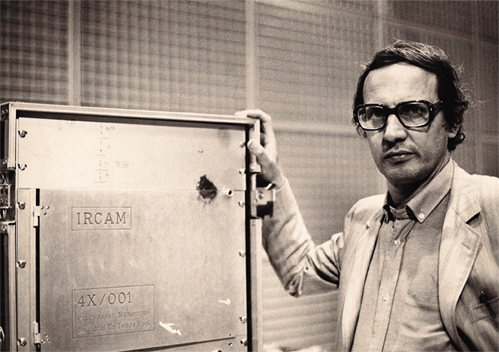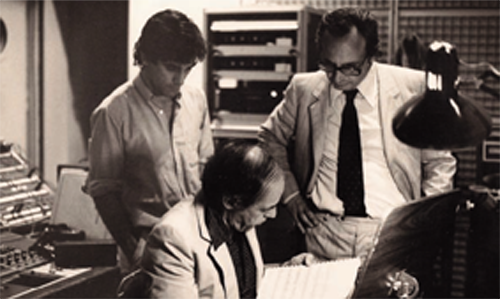Giuseppe Di Giugno (Bengasi, 1937) is a physicist, graduated from the University of Rome, that initially worked in the energy sector, collaborating even with the Cern of Ginevra in the Seventies.
Though, just in those years, he decided to leave the energy sector to work as researcher for digital audio systems and for the technological music instruments. These last activity were activated at the Physics Institute of the University of Naples, where he taught.
Very soon, due to different goals between the University and Di Giugno, this last decided to establish a group of experimental research, in 1971.
The 1971 is a very important year. Di Giugno and Robert Moog, by the Cornell University, meet together. Moog was already known for his synthetizers and this encounter has incentivated Di Giugno to develop a new instrument capable to use the computer to make music.
But in the same years, Giuseppe Di Giugno is not the only one interested to the combination of technology and music. Even Antonio De Santis, an Italian composers, pioneer for the electronic music, was interested to computer applications in music. Together, they establish the AC.EL group (ACustica/ELettronica – ACoustic/ELectronic), that today is still active even if De Santis died recently.
Di Giugno worked with this group from 1971 to 1975 but continuing to collaborate with others research center as the Bell Labs, New Jersey, and the Stanford Artificial Intelligence Laboratory (also known as Stanford AI Lab or SAIL).
In 1975 Di Giugno closes the so called Italian stage, developing the 4A processor, the first among the 4N digital signal processors developed over the years by Peppino Di Giugno. This first version, very simplified if compared to the next, was capable to synthesize 256 voices.
The 4A processor, in spite of his simplicity, was considered a very powerful DSP for those years, and so Peppino Di Giugno decided to present his machine in the United States (at Stanford and MIT in Boston). But the most importante news was that the Italian composer Luciano Berio, called by Pierre Boulez to manage the Department of Electro-acoustics at Ircam in Paris, wanted to realize in France the same project developed by Di Giugno in Italy.

Giuseppe Di Giugno near the 4X digital synthesizer.
Luciano Berio was interested to make use of an electronic instrument capable of synthesize at least 1000 different voices. For this, Berio invited Di Giugno to move at Ircam.
The Italian physicist arrived at Ircam in 1976, where he remain for six years and where he work first to a revisioned version of the 4A processor.
In 1977 Di Giugno, in collaboration with Hal Alles by the Bell Labs, realizes a new processor called simply 4B, and the following year realizes even the 4C. Many software was developed to extend the potentiality of these digital processors and though the 4C has been greatly appreciated, although none of these machines was able to satisfy the increasing needs by composers.
The main goal of Giuseppe Di Giugno, at this point, was to plan a digital electronic instrument that was not subject to technological obsolescence or to the evolution of musical ideas. So, in 1981 he developed a new DSP called 4X, based on modular technology; a machine that was used for Répons, by Pierre Boulez, and for many other musical works.

A man, Pierre Boulez and Giuseppe Di Giugno on the right.
By the 1982, he was involved even with the construction of the 4i, the DSP developed at Centro di Sonologia Computazionale (CSC), Padua, where in 1984 became the main device of the 4i System.
In the same year, 1984, was realized a second augmented version of the 4X and the Ircam gave the license rights to Sogitec. In 1985, also, the Ircam version of the 4X was given to CSC.
In 1988 was realized a final version of the 4X and was designed, hypothesized, a new version that would take the name of 5A. But this last project was just an idea, and never realized.
With the last version, ended the collaboration among Peppino Di Giugno and the French technological center. The Italian physicist moved to Italy for a collaboration with Paolo Bontempi of the Bontempi-Farfisa group. The goal was to report in Italy the technological research to developing innovative musical instruments.
So, in those years, was born the IRIS (Istituto di Ricerca per l’Industria e lo Spettacolo) in Paliano, Frosinone, 80 km from Rome. This research institute would have to realize project of new technological musical instruments for the Bontempi-Farfisa group, trough a staff formed by engineers, physicists and computer scientists.
The IRIS collaborations go ahead until the Nineties (about 1999), throughout this time the most important project, much appreciated even by international composers, was the MARS (Musical Audio Research Station), for a long time adopted by research centers devoted to computer music and by numerous music schools, at least until the diffusion of the personal computer.
Over the last years, Di Giugno was no longer interested in digital audio research, so he decided to dedicate himself to astronomy, so that he organized conferences on this topic and built two astronomical observatories near Rome.
For this topic I’ve read:
[1] Célestin Deliège, Cinquante ans de modernité musicale: de Darmstadt à l’IRCAM, Ed. Pierre Mardaga, Parigi, 2003.
[2] AA. VV., Confessioni di un fisico prestato all’elettronica: intervista con Peppino Di Giugno, Music@, Anno V, Vol. 16, 2010.
[3] AA. VV., Il complesso di Elettra: mappa ragionata dei centri di ricerca e produzione musicale in Italia, CIDIM, Roma, 1995.
